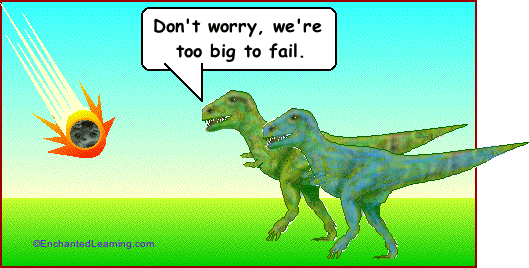Advertisement.
EnchantedLearning.com is a user-supported site.
As a bonus, site members have access to a banner-ad-free version of the site, with print-friendly pages.
Click here to learn more.
(Already a member? Click here.)
 |
DINOSAUR EXTINCTION |
 |
Extinction is the process in which groups of organisms (species) die out. If the birth rate is less than the death rate over time, extinction results. Extinction is a natural result of evolution and natural selection. Species go extinct when they are unable to adapt to changes in the environment or compete effectively with other organisms. Well over 99 per cent of the species that have ever lived have gone extinct.
 |
A graph of invertebrate extinctions over the last 600 million years.
The mass extinctions appear as periodic peaks rising above the background extinction levels. This data is from the work of D. M. Raup and J. J. Sepkoski. |
BACKGROUND EXTINCTIONS
Most extinctions (perhaps up to 95 per cent of all extinctions) occur as background extinctions, occurring throughout time. These extinctions are not caused by major catastrophes or horrendous climactic changes, but by small changes in climate or habitat, depleted resources, competition, and other changes that require adaptation and flexibility.
Most dinosaur species perished in background extinctions that occurred throughout the Mesozoic Era. For example, Maiasaura, Styracosaurus, Protoceratops, Dilophosaurus, Cetiosaurus, Iguanodon, Allosaurus, Ouranosaurus, Deinocheirus, and Edmontosaurus were probably decimated in background extinctions. The flowering plants (angiosperms) appeared during the Cretaceous period, displacing most conifers and many other plants. This had major effects on dinosaurs. Some herbivorous dinosaurs, like Edmontosaurus, ate only conifers. As flowering plants came to dominate the landscape, Edmontosaurus died out, unable to find enough conifers to sustain itself.
MASS EXTINCTIONS
A mass extinction is a relatively sudden, global decrease in the diversity of life forms. Mass extinctions have occurred periodically throughout the existence of life on Earth. To be a mass extinction, the following must occur:
- Extinctions occur all over the world.
- A large number of species go extinct.
- Many types of species go extinct.
- The extinctions are clustered in a short amount of geological time (a few million years is very short in terms of geological time).
The five largest mass extinctions in Earth's history occurred during:
- The late Ordovician period (about 438 million years ago) - 100 families extinct - more than half of the bryozoan and brachiopod species extinct.
- The late Devonian (about 360 mya) - 30% of animal families extinct.
- At the end of the Permian period (about 245 mya) - Trilobites go extinct. 50% of all animal families, 95% of all marine species, and many trees die out.
- The late Triassic (208 mya) - 35% of all animal families die out. Most early dinosaur families went extinct, and most synapsids died out (except for the mammals).
- At the Cretaceous-Tertiary (K-T) boundary (about 65 mya) - about half of all life forms died out, including the dinosaurs
 , pterosaurs
, pterosaurs , plesiosaurs, mosasaurs, ammonites, many families of fishes, clams, snails, sponges, sea urchins, and many others.
, plesiosaurs, mosasaurs, ammonites, many families of fishes, clams, snails, sponges, sea urchins, and many others.
Currently, during the modern Holocene epoch, there are large number of extinctions occuring. Many minor extinctions have also occurred through Earth's history.
THE NEMESIS HYPOTHESIS
The nemesis hypothesis of Raup and Sepkoski theorizes that there is a periodicity of 26 million years to mass extinctions which is caused by collisions with comets from the Oort cloud as they are perturbed in their orbits by a dark star (a companion star to the sun). The search for the Oort cloud continues.
THE EXTINCTION OF THE DINOSAURS
Most dinosaur species perished in background extinctions that occurred throughout their Mesozoic Era. The other dinosaur species died out during the several mass extinctions that occurred in the Mesozoic: at the end of the Triassic (213 million years ago), during and at the end of the Jurassic (at 190, 160, 144 mya), and during and at the end of the Cretaceous (at 120, 82, and 65 mya).
Too big to fail?

Don't worry, we're too big to fail.
Cope's Rule (named for the American paleontologist Edward Drinker Cope) states that organisms within a population evolve to become more massive over time. Although this increases each individual's fitness, it leaves the species more susceptible to extinction.
The Lilliput Effect (named by Adam Urbanek, 1993) notes the appearance of small body size in surviving animals after an extinction event. (The name Lilliput is from Jonathan Swift's novel Gulliver's Travels; in the novel, the Lilliputians were very tiny people.) Body size is determined by the amount of resources availabile to the species.
Enchanted Learning®
Over 35,000 Web Pages
Sample Pages for Prospective Subscribers, or click below
Click to read our Privacy Policy
Enchanted Learning Search
|
Search the Enchanted Learning website for:
|
Advertisement.
Advertisement.
Copyright ©1997-2018
EnchantedLearning.com ------ How to cite a web page

